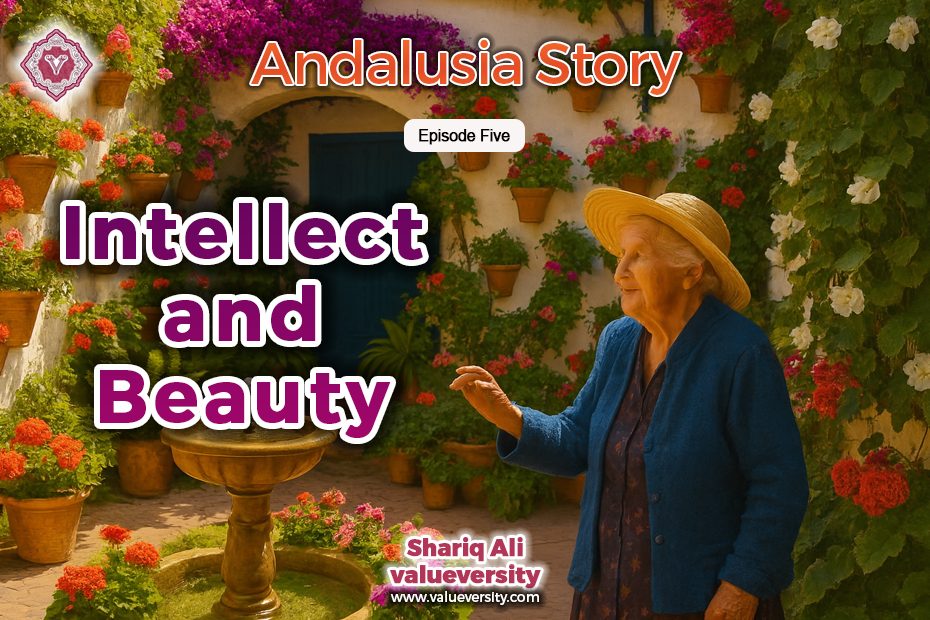Intellect and Beauty – Episode 5An Andalusian Tale
By Shariq Ali
Valueversity
We, along with all the other tourists, were walking behind our guide Pedro as we crossed the Roman bridge. Beneath our feet, the river flowed slowly. Who knows how many cataclysms this seemingly tranquil river has witnessed in the past? Countless invaders must have crossed this very river to attempt capturing the city. For centuries, this river has flowed as the natural guardian of the fortified mosque and the city of Córdoba. Who knows how many attackers’ blood has been absorbed by its waters? With a strange sense of melancholy, we crossed the bridge.
As soon as we crossed, we entered a modern-style building housing the Visitor Center. Pedro gave us a fifteen-minute break here. The center had all the amenities for freshening up—informational brochures, coffee and snack shops, and clean restrooms.
After the break, we set off towards the historic alleys of Córdoba.
Right outside the Visitor Center was a spacious square, lined with restaurants and shops. In one corner of the square stood a statue atop a tall pillar. Pedro informed us that it was the statue of Saint Raphael.
According to the Christian faith of the city, Saint Raphael is considered the protector and healer of Córdoba—much like Abdullah Shah Ghazi in our city, Karachi. Just as Shah Ghazi is believed to hold back storms, Saint Raphael is believed to have protected the people from the Black Death and helped them recover. Even today, many locals pause before his statue and offer silent prayers.
From the square, we moved onward into the old quarters of Córdoba.
The streets—some narrow but mostly spacious—were paved with stone, clean, and adorned with flowers. Around us stood historic-style homes, big and small. The weathered stones set into the ground seemed to hold the passage of time itself. I thought to myself—Ibn Rushd belonged to this city. Perhaps he too once walked through these very alleys as I am doing now. Ibn Rushd—the beacon of knowledge, wisdom, and the harmony of reason and faith.
Abu al-Walid Muhammad ibn Ahmad ibn Rushd (1126–1198) was one of the greatest sons of Córdoba. Not only a philosopher, but also a jurist, physician, astronomer, and logician. In the West, he is known as Averroes. His most significant scholarly contribution was the commentary and interpretation of Aristotle’s works. His efforts laid the intellectual foundation for the European Renaissance.
Ibn Rushd believed in the harmony between religion and reason. He held that reason is a divine gift, and its use cannot contradict faith—rather, it can complement it. Even today, the echoes of his footsteps seem to reverberate through the alleys of Córdoba. In the theatre of imagination, I saw traces of his presence—in the silence of an arch, in the scent of fresh flowers hanging from a doorway, in the extinguished flame of a lantern outside a home.
As we walked through these streets, Pedro told us about a fascinating local tradition:
Every spring in Córdoba, a competition is held for the most beautiful courtyard gardens inside homes. The city council awards prizes to the top three homes with the most beautifully adorned interior gardens. These gardens are decorated with flowers, plants, and greenery. The winning homes are then allowed to open their gardens to tourists.
As part of this tradition, we had the opportunity to visit the courtyard garden of an elderly woman. It was fragrant with flowers, covered in vines, and lovingly maintained—a living, thriving garden. Her passion for plants and flowers, along with her animated storytelling, kept us joyfully engaged for nearly half an hour.
The layout of the garden, the vintage fountains, and the vine-covered walls were all sights to behold. Spread over three floors within a small space, a delightful arrangement of pots, plants, and blossoms was on display. She explained how she nurtured them with such affection. The questions from our group and her witty and insightful replies added to the charm.
Seeing Córdoba today gives us a vivid idea of how enchanting the old city must have been—when its people cherished flowers, greenery, literature, and intellectual freedom. When thinkers like Ibn Rushd would walk through these same streets, engaged in deep philosophical discussions. When women adorned their courtyards not just with flowers, but with the fragrance of learning and culture.
This was not merely a visit to a home garden. It was a glimpse into a lost civilization—the civilization of Al-Andalus, where intellect, beauty, and love breathed together.
Then, under Pedro’s guidance, we began moving toward the Jewish Quarters. (To be continued)
